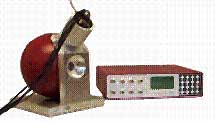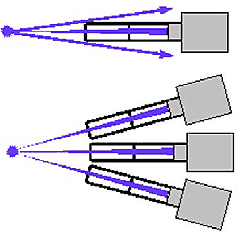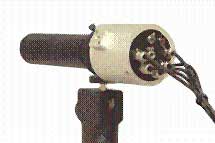VI.5. Colorimetry
Color is the attribute of visual perception consisting of any combination of chromatic and achromatic content. This attribute can be described by chromatic color names such as yellow, orange, brown, red, pink, green, blue, purple, etc., or by achromatic color names such as white, grey, black, etc., and qualified by bright, dim, light, dark or by combinations of such names.
Perceived color depends on the spectral distribution of the color stimulus, on the size, shape, structure and surroundings of the stimulus area, on the state of adaptation of the observer's visual system, and on the person's experience of prevailing and similar situations of observation. For more details about theory, see paragraph II.9 of this tutorials.
Color and Illuminance Measurement
In many applications involving the measurement of color or of the color temperature of self-emitting light sources, the same measurement geometry is used as for illuminance. Appropriate absolute calibration of the measuring system allows the illuminance of a reference plane in Lux (lx) to be determined, in addition to the colorimetric parameters. If the incident light is falling diffusely, this measurement requires the measuring system to have a field of view adapted to the cosine function. Only in this way can the laws for the incidence of diffuse radiation from one or more sources of radiation be satisfied. Detectors used to determine absolute illuminance must therefore have a cosine spatial function as their measurement geometry. If the incident radiation is not parallel, the accuracy of the cosine function is critically important to the result of the measurement. In Germany, DIN 5032, Part 7 classifies the quality of devices for measuring illuminance (luxmeters/photometers) according to the accuracy of their measurement into:
Devices of class A, with a total uncertainty of measurement of 7.5 % for precise measurements.
Devices of class B, with a total uncertainty of measurement of 10 % for operating measurements.
Since there are no equivalent regulations for colorimeters, some of the regulations in DIN-5032 can also be usefully applied to illuminance measuring colorimeters.
Color and Luminous Flux Measurement
Luminous flux is the quantity used to define all of the emitted radiation in all directions by a light source in the photometric unit, Lumens (lm). One of its purposes is to reference the efficiency of incandescent lamps, arc lamps, light emitting diodes, etc., as this is derived from the relationship between the input electrical power and the luminous flux.
In cases where the light source emits in an approximately parallel beam it is possible to measure the luminous flux with a photodetector assuming that the diameter of the beam is less than that of the detector measurement aperture. If the light beam is highly divergent, or if a 4π radiation characteristic must be considered, a measurement geometry must be used that ensures that all of the radiated light is evaluated, regardless of the direction in which it is emitted.
The measurement geometry most often used for highly divergent sources is a hollow body, ideally formed as a hollow sphere, with a diffusely reflecting interior wall. Such "integrating spheres" are known in Germany as Ulbricht spheres. The figure below illustrates the principle of its construction.

Fig. VI.16. Color and Luminous Flux Measurement Instrument with a 150 mm Integrating Sphere
Color and Luminous Intensity Measurement
The quantity of luminous intensity specifies the light flux emitted by a light source in a particular direction within a specified solid angle in the photometric units of Candela (cd). One area where it is applicable is when lamps and projectors are used in imaging systems (lens systems, reflectors), and the subsequent distribution of luminous intensity from the illumination or spotlight system must be calculated.
In order to measure luminous intensity, the field of view of the color detector must be restricted to the desired solid angle. This is usually accomplished using steradian adapter tubes that limit the detector head's field of view. It is important that the inner walls of these tubes are designed to exhibit low reflectance. Steradian tubes that attach to the front end of the detector can be used for this purpose.

Fig. VI.17. Typical Measurement Geometries
Color and Luminance Measurement
The quantity of luminance is used to evaluate the intensity of light from surface emitters in the photometric units of Candela/square metre (cd/m2). A defined angular field of view for the color measuring device is needed in order to measure luminance. This can be accomplished using either steradian tubes or lens systems.

Fig. VI.18. Color Detector Head for Measurement of Luminous Intensity and Luminance, using Gigahertz-Optik Steradian Tube System
Color Temperature Measurement
Color temperature is a simplified way to characterize the spectral properties of a light source. While in reality the color of light is determined by how much each point on the spectral curve contributes to its output, the result can still be summarized on a linear scale.
Low color temperature implies warmer (more yellow/red) light while high color temperature implies a colder (more blue) light. Daylight has a rather low color temperature near dawn, and a higher one during the day. Therefore it can be useful to install an electrical lighting system that can supply cooler light to supplement daylight when needed, and fill in with warmer light at night. This also correlates with human feelings towards the warm colors of light coming from candles or an open fireplace at night.
Standard unit for color temperature is Kelvin (K).
The kelvin unit is the basis of all temperature measurement, starting with 0 K (= -273.16° C) at the absolute zero temperature. The "size" of one kelvin is the same as that of one degree Celsius, and is defined as the fraction 1/273.16 of the thermodynamic temperature of the triple point of water, which positions 0° Celsius at 273.16 K.
Light sources are sometimes described by their correlated color temperatures (CCT). The correlated color temperature of a source is the temperature of a black body radiator that is most similar to the source. A blackbody radiator is an ideal surface that absorbs all energy incident upon it, and re-emits all this energy. The spectral output distribution of an incandescent (tungsten) lamp approximates a blackbody at the same temperature. Correlated color temperature is typically presented using the absolute centigrade scale, degrees Kelvin (K).
Some typical color temperatures are:
• 1500 K, Candlelight
• 3000 K, 200 W incandescent lamp
• 3200 K, sunrise / sunset
• 3400 K, Tungsten lamp
• 5500 K, sunny daylight around noon
For many color measurement tasks it is important to determine the color temperature of luminous objects. According to DIN 5031-P.5, the color temperature tc of a radiator requiring characterization is the temperature of a Planckian radiator at which it emits radiation of the same color type as that of the radiator being characterized. The color temperature is calculated and displayed by the meter. The calculation of color temperature is performed using an algorithm according to Qiu Xinghong, which enables very good research results for the color temperature range from 1667°K to 25000°K to be obtained.
Practical Solutions to Real Light Measurement Problems
Here's The Problem:
Your company manufactures a wide range of solid state lighting for various applications. You need to convince your customers that retrofitting their traditional site lighting with your new LED based lighting is a better way to go. But when comparing the light sources your filter based luxmeter is not doing a good job providing the light intensity and color temperature data you need to prove your claims. Also different customers are requesting different measurement quantities based on the lighting application, whether display, general, horticultural or other.
Here Are The Requirements:
- Fast accurate color, illuminance and color temperature information
- Able to measure all of the different measurands present in various lighting apps
- PAR measurement capability for horticultural applications
- TM 30-15 and CRI measurement capability for display lighting
- Multiple meters are required for sales reps and installation & service techs, requiring a cost effective solution
Here's The Solution:
Gigahertz-Optik's handy MSC15 spectral light meter. It's light & color measurement made simple.
More Gigahertz-Optik light measurement instrumentation can be found on www.gigahertz-optik.com.
Interested in discussing your light measurement application?
Give us a call!

